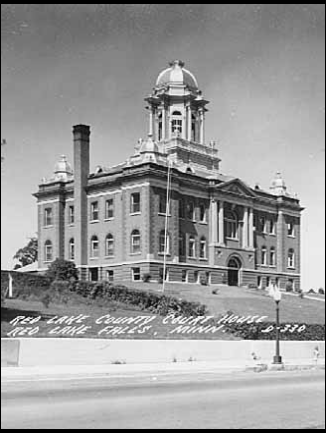 |
|
|
Why Red Lake Falls established itself early with a certain lavish attitude towards liquor, may have been perpetuated by the half dozen or so saloons here since the late 1800’s. Shut down at the dawn of 1920 prohibition were six saloons and a distributor - those owned by Krueger, Champeau, Latendresse Bros., Kroll and Miller, Deutschman and J. E. Savard.
The first prohibition trial swooped Red Lake Falls by surprise August 13, 1918 when agents from the Minnesota Public Safety Commission closed up the town’s saloons without warning, confiscated the stocks and sent them to wet territory. Red Lake County was the only wet county in the whole northwest and the dryup was a thunderbolt to the locals.
A little less than a year later, the National War Prohibition Act went into effect July 1, 1919. This time the saloons were well prepared for the floodwater of foreigners from surrounding dry territories seeking several month’s supply to last through the drought. The local Gazette reported the town was “loaded to the gills” with liquor for sale; strange and expensive cars were lined six blocks for two straight weeks in front of the supply house and bars before the act went into effect. Just before midnight July 1, every saloon in town was cleaned of its stocks; Plummer too.
At this time, John E. Savard, a Louisville farmer, was operating a lucrative saloon on Main Avenue called the “White Front”. One son, Lorenzo, known as “Kaiser” by his friends, was to claim fame as an alky runner and the most notorious speakeasy owner and bootlegger in northwestern Minnesota, and around him the legacy of the prohibition days of Red Lake Falls is centered. He started “his foray” with the Jewel Tavern and its mouthwatering ribs. He built the Green Lantern, a legal restaurant, and added nightclubs at Walker, Crookston and Angus - all had small change slot machines, then legal under Minnesota law.
But Kaiser didn’t make his reputation on ribs and dancing; the dollars flowed from sales of illicit pure alcohol and moonshine. He was the kingpin of liquor running throughout the 13 years of prohibition. Farmers made moon for Kaiser, only the best accepted. He made weekly trips to Chicago with his Cadillac for whiskey, and there was little problem running across the border to Canada. His cars had special suspension systems to support the extra weight of the gallon alcohol tins fitted into the trunk and secret pockets of his high-powered cars. A low trunk was a sure giveaway to the feds.
Back in town, Kaiser stored much of the alcohol in the back of shops and had a shed west of town and used the old Savard farm.
Of course, a man with so many operations was being watched by the feds, but Kaiser kept two steps ahead of the law at all times. Alky running was good money for the short time it lasted; the final blow was dealt by the Minnesota governor who outlawed slot machines. That was the end, and by 1930 the IRS had begun examining Kaiser’s accounting and began the slow siezure of Kaiser’s holdings including the Green Lantern and the other nightclubs fell in succession.
Red Lake Falls benefited greatly from Kaiser’s generosity. It is said he turned over every penny of his wealth back into the depressed town during the depression. Even for the sinister risks involved with his kind of business, Kaiser brought no harm to this city; there never was a gang war or cut-throat slaying. Red Lake Falls much accepted their kingpin alky runner.
Kaiser spent the rest of his life in Red Lake Falls except for a hitch during WW11. He was elected to the city council and served a total of eight years and died Feb. 24, 1973 at the age of 69.